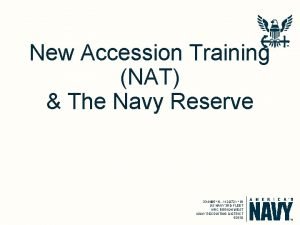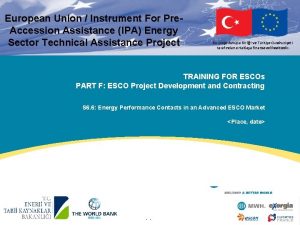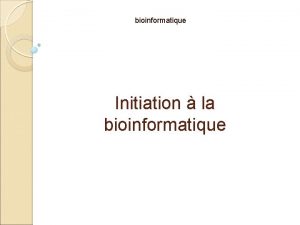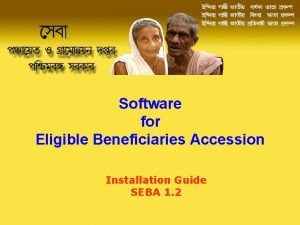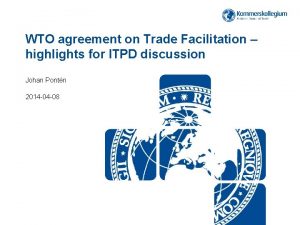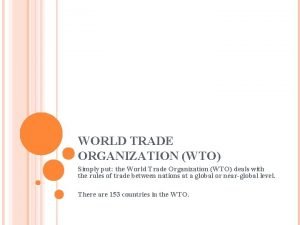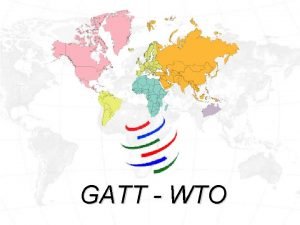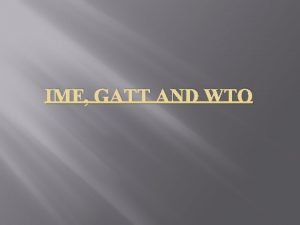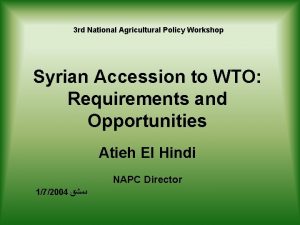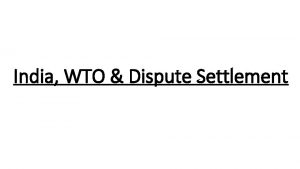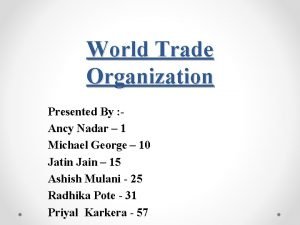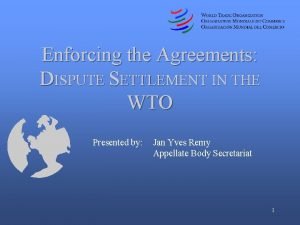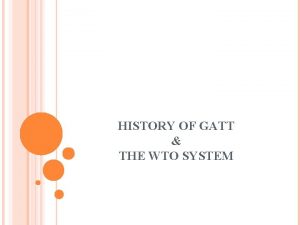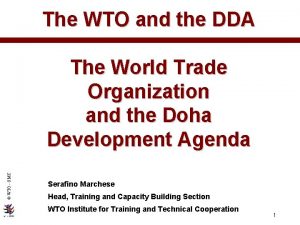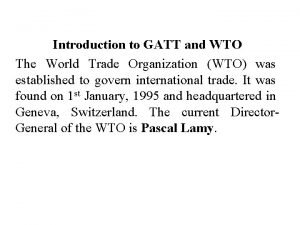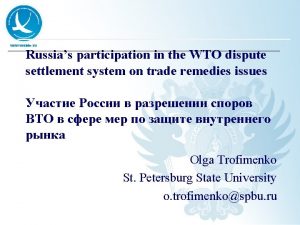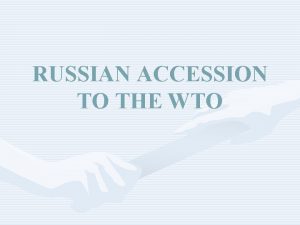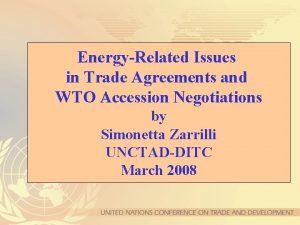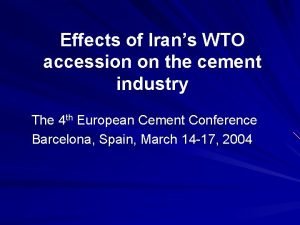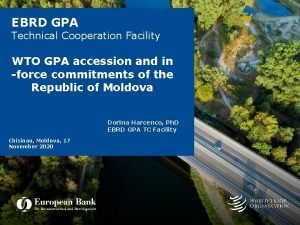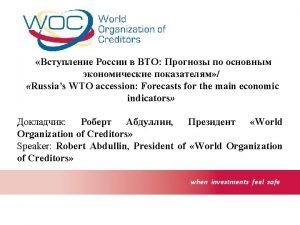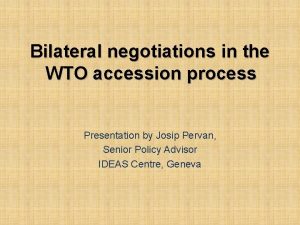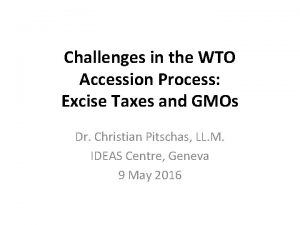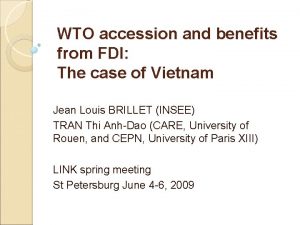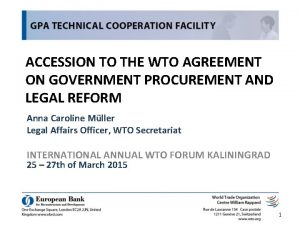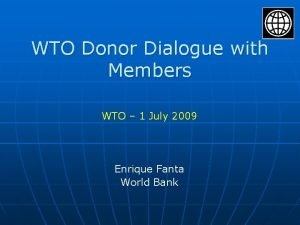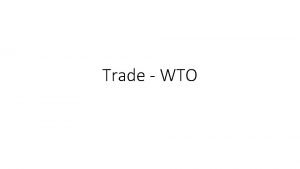www worldec ru Accession to the WTO impact

















- Slides: 17

КАФЕДРА МИРОВОЙ ЭКОНОМИКИ Санкт-Петербургский Государственный Университет Экономический факультет www. worldec. ru Accession to the WTO: impact on inward FDI Sergei F. Sutyrin, Professor, the WTO chair-holder, World Economy Department Head Dmitriy N. Kolesov, Associate Professor, Economic Cybernetics Department Head St. Petersburg State University, Russian Federation

WTO and FDI www. worldec. ru Because the benefits which the WTO brings to the world economy come primarily via the impact of the WTO on investment decisions, it is no exaggeration to say that investment is at the heart of the WTO. “Trade and foreign direct investment” Report by the WTO” October 1996 Russia and WTO 2

WTO and FDI www. worldec. ru Among major positive repercussions of RF WTO accession – expansion of inward FDI Due to: - Better business environment - GATS - TRIPs - TRIMs Despite of partly alternative relation between FDI and foreign trade

WTO and FDI www. worldec. ru Foreign investments inflows to Russia: I- half 2013 / I- half 2012 = 132. 1%, including: FDI= 159. 8% among them loans from foreign co-owners – 2. 3 times more According to UNCTAD in 2013, RF (with $94 bln. ; + 83%) was the 3 d largest recipient of foreign investments on the globe after US ($159 bln. ) and China (127 bln. )

WTO and FDI www. worldec. ru

WTO and FDI www. worldec. ru At the moment for RF the WTO is far from being “the only that matters” Western sanctions (≈$40 bln. ), contraction of oil prices (≈$90 - $100 bln. ), devaluation of RUR, etc. are more significant Russia and WTO 6

WTO and FDI www. worldec. ru The challenge – how to separate general impact of the WTO accession/membership on Russian economic performance from other factors’ one. An option – to look at international experience Two initial hypotheses: - Russia ultimately is not that different from other countries - Large number of observations with similar results might turn “post-hoc” type of relations into ”due to” one 7

WTO and FDI www. worldec. ru 29 non-GATT member-countries (including Russia) acceded to the WTO between 1995 and 2012 All of them experienced certain impact of accession Why not to investigate developments of their relevant indicators? 8

WTO and FDI www. worldec. ru The list of countries: Albania, Armenia, Bulgaria, Cabo Verde, Cambodia, China, Croatia, Democratic Republic of the Congo, Estonia, Georgia, Jordan, Kyrgyzstan, Latvia, Lithuania, Macedonia, Moldova, Mongolia, Montenegro, Nepal, Oman, Panama, Russia, Samoa, Saudi Arabia, Taiwan, Tonga, Ukraine, Vanuatu, Vietnam 9

WTO and FDI www. worldec. ru Dates of accession differ from Dec. 1996 (Bulgaria) to Aug. 2012 (Russian Federation, Vanuatu) How to compare? “Floating time-frame” – two years before the accession in comparison with two years after the accession Accession in June vs. accession in July 10

WTO and FDI www. worldec. ru Focus on relative indicators – how did average rate of growth change two years after accession in comparison with two years prior? Positive vs. negative dynamics Data mostly from the same source of UNCTAD statistics 11


Russia and the WTO www. worldec. ru FDI inflows annual growth rate after the accession for individual countries fluctuated between -100% (Kyrgyzstan, Tonga ) and + 238. 6% (Democratic Republic of the Congo) positive dynamics in annual rate took place in 9 cases out of 24 while negative dynamics – in rest 15 cases 13

di a Ch in a Cr oa tia Es to ni G a eo rg ia Jo K rda yr n gy zs ta n La t Li via th ua n M ia ol do M va on M gol ia on te ne gr Pa o Sa na ud ma i. A ra bi a Ta iw M ac an ed on ia To ng U a kr ai ne V ie tn am D R Co ng o bo de ar ia er V m Ca bo Ca ia ia en an lg Bu rm -20, 0 A lb A Growth rate of inward FDI stock, annual, %% www. worldec. ru 80, 0 60, 0 40, 0 20, 0 -40, 0 -60, 0 Before the WTO accession After the WTO accession 14

Russia and the WTO www. worldec. ru Inward FDI stock annual growth rate after the accession for individual countries fluctuated between -11. 7% (Democratic Republic of the Congo) and +56. 0% (Croatia) positive dynamics in annual rate took place in 11 cases out of 21 while negative dynamics – in rest 10 cases 15

To conclude www. worldec. ru Amazingly large difference of growth rates between the countries under review Amazingly small difference between the countries that experienced positive and negative dynamics The WTO is far from being “the only that matters” In a sense WTO membership – purchase of expensive tool. To those who know how to use - gains. To those no necessary skills - extra expenses with no rewards. 16

www. worldec. ru Thank you very much for your attention! 17
 Navy nat program
Navy nat program Hesse eva
Hesse eva Ipa instrument for pre-accession assistance
Ipa instrument for pre-accession assistance Allintitle accession à la propriété
Allintitle accession à la propriété Rhs seba
Rhs seba Organs of wto
Organs of wto Explain the objectives of wto
Explain the objectives of wto Uklad gatt
Uklad gatt Wto objectives
Wto objectives Function of world trade organization
Function of world trade organization Structure of wto
Structure of wto Objectives of wto
Objectives of wto Pengertian ifc
Pengertian ifc Wto dispute settlement mechanism
Wto dispute settlement mechanism Wto
Wto Wto
Wto Wto functions and objectives
Wto functions and objectives Principles of wto
Principles of wto
